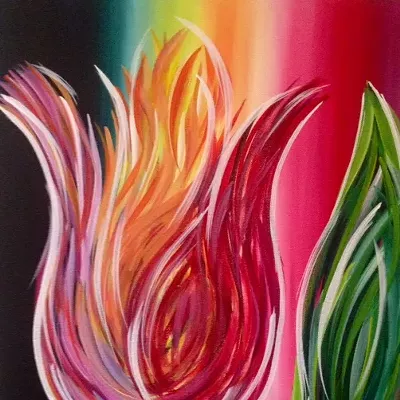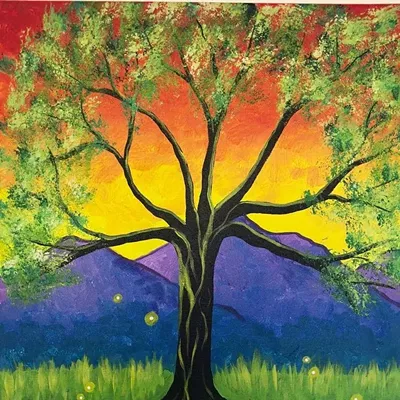Green, a San Diego painter, is the guest artist in a glittering three-person show at Dinnerware Contemporary Art Gallery. He does wonderful small paintings in oil and wax on plywood, elegant abstractions that seem to be all about mood and color.
But hold onto that word "seems." Green's work looks abstract for only a few minutes. Upon more leisurely inspection, his paintings make a startling metamorphosis from abstraction into representation. Their seemingly careless swathes of color coalesce into honest-to-goodness houses, endowed by their creator with classic pointy roofs and chimneys, gables and porches, and secured within ambiguous landscapes. Clouds, light, wind and turf buffet these organically shaped bits of architecture.
The houses don't mind curving in a way real-life lumber rarely does. They loop willfully away from the architect's straight edge, and their easy-going softness matches the organic palette. Green loves greens from olive to lime, and yellows from lemon to ochre, and these warm earth tones are loosely lavished on the unabsorbent surface of the wood. Each of his untitled works strikes a different mood. A white house with a red tile roof sways in a grove of purple trees, or could that purple be the sheltering shadow of a mountain? Another painting has green trees leaning toward a tight frontal image of a house facade in yellow amber, drenched in sunlight.
Green describes his works as "anonymous architectural settings involving invented light, time of day and weather." They're among the most purely mesmerizing paintings seen around these parts in some time. Lyrical and lively and lovingly painted, they're impossible either to pin down or to grasp entirely. One moment you see an abstraction in sage green, another moment a sturdy little house pushing out of the colors. Next thing you know the house dissolves again, an ungraspable mirage. Moving between seen and unseen, the paintings also tap into Everyone's memories of home. The houses evoke the remembrance of things past, undulating on waves of knowing and forgetting.
Betina Fink's houses are not so elusive. Her oils on canvas are more straightforward renderings of the objects she sees inside her studio, or the fragments of landscape or roofline she glimpses outside her windows. A member of the artists' colony at Rancho Linda Vista in Oracle (and current president of Dinnerware), what Fink sees most often beyond the panes is a lighted desert landscape. In "Studio Doors," for instance, red-painted French doors frame a sun-washed palo verde tree. The grid of wood and glass contrasts with the natural curves of nature outside, and the punchy red paint reverberates against the soft desert greens. "House" offers a detail of a Mission style home in white with deep-red roof.
But not for nothing did Fink spend seven years in the Netherlands, home of quintessential still lifes and painted domestic interiors. Fink's "Delft Window" is a deft homage to Vermeer, the master of both genres and an incomparable painter who captured light pouring through windows as no one has before or since. Fink's casement window is a charming blue mullioned affair, very Dutch. The glass is ajar, pulled into the room, allowing sunlight to flood in through the window opening at left. In Fink's attention to detail and color and light, the interior and the still life merge.
Elsewhere she turns her fascination with doors and windows into lively geometric compositions. "Little Street Door" boldly magnifies a deep maroon door and its adjoining windows and crops their edges. The painting thus becomes a flat, pleasing array of rectangles in assorted dimensions and colors: orange, red and maroon. It's a kind of abstraction, but more Mondrian than Mark Green.
In fact, the pairing of Green's and Fink's work is inspired. Both painters do houses, both do representation and both do abstraction, but it's an absorbing occupation to meditate on the fact that their paintings are about as different as California and Holland, one free-form and misty, the other disciplined and methodical.
Sculptor Selina Littler provides the landscaping for these two painters' architectural conceptions. All around the floor of the gallery, the front yard, you might say, of the painted houses, are Littler's desert branches twisted and tied into new shapes. For "Up," Littler, another RLV'er, has lashed manzanita sticks into a ladder, and planted a big cracked egg cozily on one step.
"Assembly Line" is a long, dried-out branch lying along the floor, adorned with a series of manzanita twigs. The small branching manzanitas are plugged upright into the bigger branch, pioneers homesteading new territory. The first manzanita is bare, but the second has the beginnings of a tiny nest. The third has a nest farther along toward completion, and so on up through four and five. Branch number six has a full-fledged nest. Lined with leaves, it's still another dwelling in this exhibition, an art home sweet home.
A show of paintings by Mark Green and Betina Fink, and sculpture by Selina Littler, continues through Saturday, May 20, at Dinnerware Contemporary Art Gallery, 135 E. Congress St. Gallery hours are noon to 4 p.m. Tuesday through Saturday, noon to 7 p.m. on Artwalk Thursdays, and 7 to 9 p.m. on Downtown Saturday Nights. For more information, call 792-4503.













